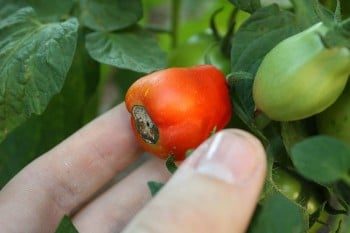
If you’ve ever had tomatoes with tomato blossom end rot, you don’t want that experience again. Seeing lovely red fruits ruined by expansive blotches of dead tissue is a sad end to tomato hopes and dreams. But there are precautions that can help you avoid this miserable affliction.
Blossom end rot is a condition occurring in many soft fruits, including peaches, apricots, apples, pears and tomatoes. The disorder is caused by insufficient calcium, and fluctuations in the plant’s water supply are an underlying cause. Tomatoes require calcium at all times and will take it from the soil, providing sufficient water is present for their roots to function. But when plants endure periods of drought, and then are inundated with water, the normal balance of nutrition is disrupted. Dry brown lesions may appear on tomatoes and then expand into leathery black blotches. Once the spots occur, it’s impossible to save the afflicted fruit.
Maintaining consistent irrigation is the key to preventing blossom end rot in tomatoes grown in the ground or in containers. Begin with a friable organic soil that will remain consistently moist and allow drainage of excess water (flooding the tomatoes is not helpful). Apply mulch (such as leaves or shredded bark) over the root zone to help conserve soil moisture and moderate soil temperature in periods of summer heat.








